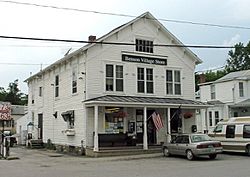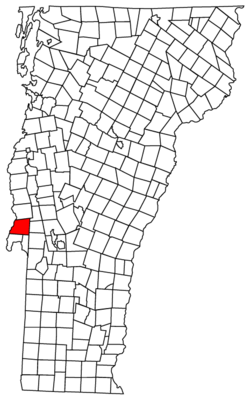Benson, Vermont facts for kids
Quick facts for kids
Benson, Vermont
|
|
|---|---|

Benson Village Store
|
|
| Nickname(s):
The Viper of Revolution
|
|
| Motto(s):
"Fight or Die"
|
|

Benson, Vermont
|
|
| Country | United States |
| State | Vermont |
| County | Rutland |
| Communities |
|
| Government | |
| • Type | Selectboard |
| Area | |
| • Total | 45.5 sq mi (117.8 km2) |
| • Land | 44.0 sq mi (113.9 km2) |
| • Water | 1.5 sq mi (4.0 km2) |
| Elevation | 479 ft (146 m) |
| Population
(2020)
|
|
| • Total | 974 |
| • Density | 21.41/sq mi (8.268/km2) |
| Time zone | UTC−5 (Eastern (EST)) |
| • Summer (DST) | UTC−4 (EDT) |
| ZIP codes |
05743, 05731 (Benson)
05760 (Orwell) |
| Area code | 802 |
| FIPS code | 50-05200 |
| GNIS feature ID | 1462040 |
| Website | https://www.bensonvermont.gov/ |
Benson is a small town in Rutland County, Vermont, United States. In 2020, about 974 people lived there. It's a quiet, rural town. Most homes and businesses are in Benson village. This area is where Stage Road and Lake Road meet.
Contents
Economy in Benson
The town's economy relies on small businesses. Many of these are found in the central village. This area is also called the central business district. It's located around the intersection of Lake Road and Stage Road.
Local Businesses and History
A key business was the C.J. Williamson store. It sold groceries and gas. This store helped the town grow apart from the larger Fair Haven area. It opened in 1912. Sadly, the Benson Village Store (also known as Williamson's) burned down in April 2019.
Another important spot was the Wheel Inn. This tavern served American food. It had been open for a very long time. An old public house from the American Revolutionary War used to be on the same site. It was a meeting place for soldiers.
Geography of Benson
Benson covers about 45.5 square miles. Most of this area is land, about 44.0 square miles. The rest, about 1.5 square miles, is water. The town has about 53.4 miles of local roads.
The Famous Benson Sycamore Tree
A special landmark in Benson is the Sycamore Tree. You can find it on Stage Road. It stands on what used to be the property of Lieutenant Colonel John Trutor. Before he owned it, the property was an inn. Tourists traveling through Vermont would stay there.
Two famous people, John Blackburn and Karl Suessdorf, stayed at this inn. They wrote the song "Moonlight in Vermont" while they were there. They even mentioned the huge Sycamore tree in their song! A small plaque on Stage Road tells about this musical moment.
History of Benson
Benson has a rich history, starting in the late 1700s.
Early Settlers
In 1777, Walter Durfee was the first person to settle in Benson. He was a veteran of the Revolutionary War from Massachusetts. At that time, the only road was a military path. General St. Clair's army used it when they left Ticonderoga in 1777.
Durfee found his way through the woods by following marks on trees. For a while in 1782, he was the only person living in the town. He built a log house on what became known as the Home Farm. He lived there until 1835. In 1783, Jonathan Meacham and Captain James Noble also came to Benson to settle.
How Benson Got Its Name
People aren't completely sure how Benson got its name. Many historians think it was named after Egbert Benson. He was a respected lawyer and officer during the American Revolutionary War. He helped settle a land dispute between New York and Vermont. This was important for Vermont to become a state.
Some local residents have different ideas about the name. For example, Lilian Snyder Philips Smith believed it was named after her ancestor, Benson Philips. He was an early leader who helped start the town's first school in 1813. However, other historians have questioned this story.
Town's Political Journey
Benson has seen many different political ideas over the years. The town has had people with views from various political groups. Local historian Genevieve Trutor was surprised by how progressive Benson was at times. She noted that Susannah W. Nifong served as a representative in the 1920s. This was unusual for the time.
Bicentennial Celebrations
In 1976, the United States celebrated its 200th birthday. Benson had big celebrations, and there was a friendly competition with the nearby town of Orwell. Both towns wanted to have the best party! Benson's parade is still an important part of its history.
School Budget Challenge
In 1994, Benson became known for something unusual. The town failed to approve its school budget eighteen times before it finally passed. This was a national record at the time.
Benson Village Historic District
In 1978, Benson Village was officially added to the National Register of Historic Places. This means it's recognized for its important historical buildings and areas. You can find more details about it here: Benson Village.
Population of Benson
| Historical population | |||
|---|---|---|---|
| Census | Pop. | %± | |
| 1790 | 658 | — | |
| 1800 | 1,159 | 76.1% | |
| 1810 | 1,561 | 34.7% | |
| 1820 | 1,481 | −5.1% | |
| 1830 | 1,493 | 0.8% | |
| 1840 | 1,403 | −6.0% | |
| 1850 | 1,305 | −7.0% | |
| 1860 | 1,256 | −3.8% | |
| 1870 | 1,244 | −1.0% | |
| 1880 | 1,104 | −11.3% | |
| 1890 | 880 | −20.3% | |
| 1900 | 844 | −4.1% | |
| 1910 | 813 | −3.7% | |
| 1920 | 807 | −0.7% | |
| 1930 | 636 | −21.2% | |
| 1940 | 572 | −10.1% | |
| 1950 | 573 | 0.2% | |
| 1960 | 549 | −4.2% | |
| 1970 | 583 | 6.2% | |
| 1980 | 739 | 26.8% | |
| 1990 | 847 | 14.6% | |
| 2000 | 1,039 | 22.7% | |
| 2010 | 1,056 | 1.6% | |
| 2020 | 974 | −7.8% | |
| U.S. Decennial Census | |||
In 2000, there were 1,039 people living in Benson. There were 391 households, and 272 families. The town had about 23.6 people per square mile. Most of the people living in Benson were White (about 96.92%). A small number were African American, Native American, or Asian. About 0.87% of the population was Hispanic or Latino.
Age and Households
About 35.8% of households had children under 18 living with them. About 55.0% were married couples. Around 24.8% of households were single individuals. About 9.5% of households had someone aged 65 or older living alone. The average household had 2.57 people.
The median age in Benson was 36 years old. About 28.3% of the population was under 18. About 11.7% were 65 years or older.
Infrastructure in Benson
Benson has one public school. It teaches students from pre-school up to sixth grade. Older students go to Fair Haven Union High School nearby.
The town's municipal building has a small museum. It also holds the town offices and the Town Clerk. Next door is the Community Hall. This building is a public meeting place and has the town library. The State of Vermont also has a boat launch called Benson Landing on Lake Champlain.
Notable People from Benson
- Charles A. Corbett — A state assemblyman from Wisconsin, born in Benson.
- Stephen Wallace Dorsey — A US senator from Arkansas, born in Benson.
- William B. Franke — Secretary of the Navy, who retired in Benson.
- Rufus Wilmot Griswold — A writer and editor known for his arguments with Edgar Allan Poe.
- Rebecca Wilder Holmes — A violinist and music professor at Smith College.
- Loyal C. Kellogg — An Associate Justice of the Vermont Supreme Court, who lived in Benson his whole life.
- Stone Phillips — A broadcast journalist, known for co-anchoring Dateline NBC, who lived in Benson seasonally.
See also
 In Spanish: Benson (Vermont) para niños
In Spanish: Benson (Vermont) para niños


